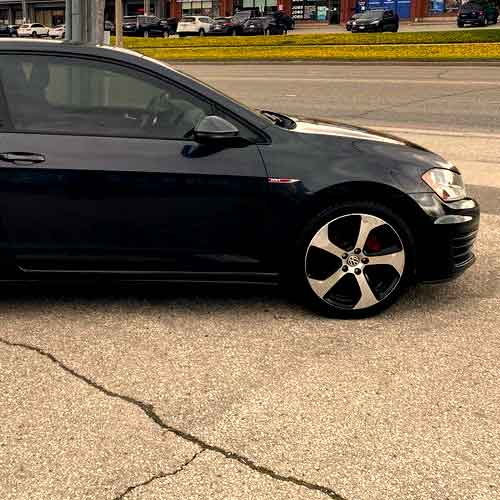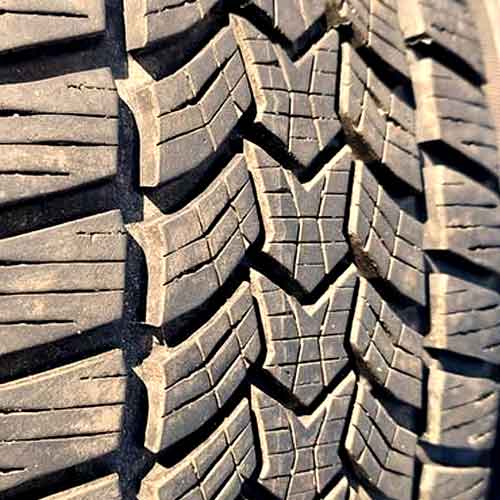Both the Debica Frigo HP2, and the Frigo 2 are great, where the updated model gets to offer slightly more. Let’s check the performance of both tires in detail.

Table of Contents
Key Takeaway
The Debica Frigo 2 excels in:
- Fuel Economy: The tire displays superior fuel efficiency due to its shallower tread depth and more streamlined lugs.
- Wet Traction: The tire stands out with its assertive siping design that seamlessly combines rectilinear and interlocking slits.
- Snow Performance: It’s tread is more optimized for soft snow.
- Handling: The tire’s denser shoulder lugs and shallower tread depth make it a formidable contender in the handling department.
The Debica Frigo HP2 excels in:
- Directional Grip (on dry roads): Where it features distinctive rib, leading to shorter braking distances.
- Hydroplaning Resistance: With the advantage of a more profound tread depth, the Frigo HP2 showcases superior resistance to hydroplaning.
- Ice Performance: The tire offers better traction, with its better biters (more optimized for ice).
- Vibration Absorption: Where the tire offers advanced compound (though its performace is similar to its counterpart, for the most part).
- Noise Generation: While initial noise levels are on par with its competitor, over time, the softer compound of the HP2 might amplify resonance noise.
Sizes Info
The Debica Frigo HP2 comes in 15 to 18 inches with following specs.
- Speed ratings: T and H.
- Load ratings: SL and XL.
- Tread depth: 12/32″.
- Weight: 16 to 28 lbs.
- Tread warranty: None.
On the other side, the Debica Frigo 2 comes in 15 to 18 inches, with following specs.
- Speed ratings: T on all.
- Load ratings: SL and XL.
- Tread depth: 10/32″ on all.
- Weight: 17 to 28 lbs.
- Tread warranty: None.
Dry Longitudinal Grip
The capability of a tire to maintain directional grip is largely contingent on the central area of the tread, as this part bears the majority of the tire’s load during linear driving.

Examining this factor, one can understand why the Debica Frigo HP2 thrives in this area, as it comes with a more streamlined, continuous central rib, providing greater contact with the ground.
In comparison, the Debica Frigo 2 sports in-groove biters or notches, which subtract from the rubber that could have made contact with the ground, thus compromising directional grip.
Consequently, Debica Frigo HP2 offers shorter braking distances, a direct measure of directional grip.
Dry Handling
The core of a tire’s handling or lateral traction rests on the performance of its shoulder lugs.
As the tire navigates through corners, the weight is redistributed towards the edges, or the shoulders of the tread. The efficiency of these lugs in adhering to the road underscores the overall handling capabilities.
Here, the Debica Frigo 2 claims an advantage due to its less deep tread and denser shoulder lugs. Its compact shoulder design ensures superior road contact while cornering, as more of its shoulder lugs engage with the road surface.
Additionally, its shallower tread depth means that its lugs are less susceptible to flexing or bending as the tire negotiates corners. This leads to more balanced steering feedback and, consequently, superior handling.
So overall its a win for Frigo 2.
Fuel Economy
Fuel consumption is influenced by the tire’s adhesion to the road and its overall structural weight.
Now both tires offer almost similar weighing structures, (comparing their all sizes, show that their average weight is similar).
But still, the Debica Frigo 2 takes the lead, showcasing lower rolling resistance, in comparison. But why is that happening? There are two main reasons.
First, the tire’s comes with shallower tread depth on average, so it’s lugs aren’t as prone to bending, as they are on the HP2.
With lugs bending, more energy is wasted in to re-molding of the tread and heat.
Moreover, moving towards the second point, the tire Frigo 2 offers more streamlined lugs in comparison, which are easier to roll.
So overall fuel economy is better on Debica Frigo 2.
Wet Traction
Wet traction is greatly influenced by a tire’s tread pattern and the rubber compound it employs. These elements dictate the tire’s ability to grip wet surfaces and ward off hydroplaning.
Now, although both tires come with a lot of biters, the Debica Frigo 2 still edges ahead in wet grip due to its more assertive siping design, which combines rectilinear and interlocking slits.
Moreover, the tire also comes with multiple biters, further amplifying its wet grip.
To explain, sipes basically push out air (as air is always inside all tread elements), and this creates a vacuum, which sucks up water particles.
And with less effective siping structure, the Frigo HP2 lacks here.
Though the main reason why its overall wet performance isn’t outperforming here, is its lacking resistance to hydroplaning. Let me discuss it in a separate section.
Hydroplaning Resistance
Hydro or aquaplaning occurs when a tire starts to literally float over water. And that happens when water isn’t efficiently/effectively evacuated through the grooves.
Now although both tires offers decent voids to channel water out, the Frigo HP2 has the advantage of more tread depth, going up to 12/32″.
This allows for greater volume of water evacuation at a given time, improving its overall hydroplaning resistance.
So how it improves its wet traction?
Well, more water channeling out via grooves, technically means, sipes don’t have to work so hard (on the remaining water left behind coming under the tire).
So overall wet performance is superior on Debica Frigo HP2, compared to Frigo 2.
Snow Performance
On soft snow, both tires showcase exemplary competence, where each is ingeniously designed to deliver premium performance, though the Debica Frigo 2 still gets to have the upper hand.
And that’s all thanks to its unique tread pattern, which is roomy and equipped with lugs to facilitate snow-to-snow contact.
The tire technically offers better tread voids, which operate as snow trappers, proficiently capturing snow particles and creating a corresponding layer of snow that interacts with the ground as the tire rolls along. This results in superior traction because, intriguingly, snow adheres better to snow than to rubber.
On the flip side, the Debica Frigo HP2 employs a less aggressive strategy, particularly concerning heavier snow. Its compact and less assertive tread pattern does not accumulate snow as efficiently.
Therefore, the Debica Frigo 2 emerges as the superior choice when performance on snow is the primary concern.
Tread Life
When it comes to tread life, winter tires often find themselves at a disadvantage due to their softer rubber composition, which tends to wear more rapidly. As a result, it is not surprising that both tires exhibit similar, albeit not exceptionally impressive, performance in this regard.
The Debica Frigo 2, fashioned with a thermally adaptive rubber specifically engineered to endure the harsh temperatures of winter, is prone to faster wear.
Nevertheless, its lifespan gains a reprieve due to its deeper tread depth. While its rubber might be softer and is prone to wearing, the additional tread depth allows for extra mileage before hitting the 2/32″ tread depth, which is the legal limit for driving.
Thus, despite its rapid-wearing rubber, the Firgo 2 still takes longer, and gives you more mileage in total.
Ice Performance
On icy terrains, the Debica Frigo HP2 distinguishes itself with its unique tread design, characterized by varied angular cuts and notches.
This design, augmented by the tire’s profuse siping, guarantees accelerated braking and enhanced handling on ice.
Meanwhile, the Frigo 2 is somewhat overshadowed in this domain, attributed to its broader tread voids and sparser notches, essentially, it has fewer gripping elements across its tread surface.
Consequently, it struggles to match the icy grip of its competitor.
Verdict: The Debica HP2 stands out with superior grip and control on icy surfaces.
Vibration Absorption
Viewing tires as a vehicle’s secondary suspension system, the Debica Frigo HP2 offers a pretty decent overall performance, with its advanced compound, offering not only superior thermal adaptability on snowy terrains but also excellent cushioning against the imperfections of the road.
As the tire interacts with uneven surfaces, its construction proficiently diffuses these disturbances, resulting in a pretty smooth ride.
Though its only just as good as its competitor.
Basically the Frigo 2 has the advantage of more tread depth, which means, there’s more room for bumps to settle down.
So overall, both tires get equal scores in terms of impact comfort performance.
Noise Generation
Tire noise is predominantly generated from the air that enters through the sides or shoulder voids and strikes the surrounding walls, creating unwanted sound waves.
This noise is further amplified by the phenomenon known as in-groove resonance, where echoing occurs.
While the Debica Frigo HP2 initially produces similar noise levels, its softer compound tends to generate larger resonance values over time, making it louder.
On the other hand, the Debica Frigo 2 pulls ahead, courtesy of its advanced pitch sequencing technology.
This technique, involving variations in tread block geometry, generates different sound frequencies that effectively cancel each other out, reducing resonance noise.
To Sum Up
In analyzing these two tires, you get to see that they both have their pros and cons.
When it comes to fuel economy, the Frigo 2 offers better efficiency, largely attributed to its shallower tread depth and more streamlined lugs. And very same reason also helps the tire with braking and handling too.
In wet traction, the Frigo 2 demonstrates superior wet grip, but the HP2 exhibits better hydroplaning resistance due to its deeper tread.
And this also helps the tread, when it comes to tread life, even though both tires don’t offer any warranties.
As for snow performance, the Frigo 2’s unique tread pattern provides a slight edge, and when transitioning to icy terrains, its design ensures stronger control and grip.
Moving further, vibration absorption is a draw between the two tires, each offering commendable comfort levels. But in terms of noise generation, the HP2 may become louder over time, whereas the Frigo 2, with its advanced pitch sequencing, stands out for reduced noise levels.